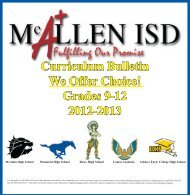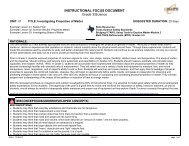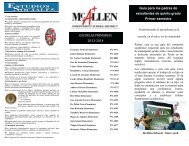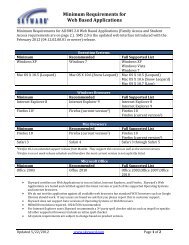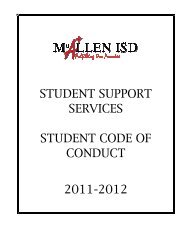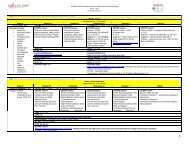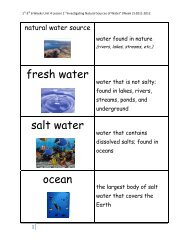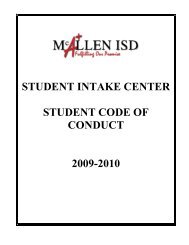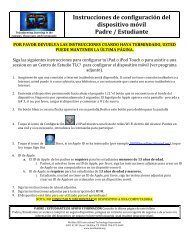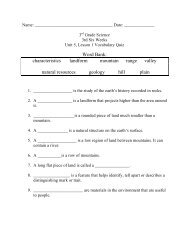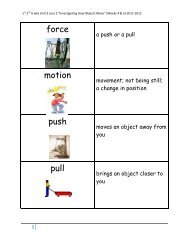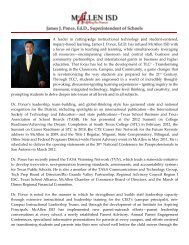elementary student-parent handbook 2012-2013 - McAllen ISD
elementary student-parent handbook 2012-2013 - McAllen ISD
elementary student-parent handbook 2012-2013 - McAllen ISD
Create successful ePaper yourself
Turn your PDF publications into a flip-book with our unique Google optimized e-Paper software.
ELEMENTARY<br />
STUDENT-PARENT<br />
HANDBOOK<br />
<strong>2012</strong>-<strong>2013</strong><br />
1
PARENT CONSENT TO ACCOUNTABILITY<br />
I understand and consent to the responsibilities outlined in the <strong>McAllen</strong> <strong>ISD</strong> Student Parent<br />
Handbook and the Student Code of Conduct. I also understand and agree that my child shall<br />
be held accountable for the behavior and consequences outlined in the Student Parent<br />
Handbook and the Student Code of Conduct at school and school-sponsored activities,<br />
including school-sponsored travel and any school-related misconduct, regardless of time or<br />
location. I understand that any <strong>student</strong> who violates the rules in the Student Parent Handbook<br />
and the Student Code of Conduct shall be subject to disciplinary action. I am also aware that<br />
the use of tobacco products by any individual is prohibited on all District property.<br />
Regarding <strong>student</strong> records, federal law requires that ‘directory information’ on my child be<br />
released by the <strong>McAllen</strong> <strong>ISD</strong> to anyone who requests it unless I object in writing to the<br />
release of any or all of this information. This written objection must be filed within ten<br />
school days of the time this <strong>handbook</strong> was given to the <strong>student</strong>. Directory information<br />
ordinarily includes the <strong>student</strong>’s name, address, telephone number, date and place of birth,<br />
participation in officially recognized activities and sports, weight and height of members of<br />
athletic teams, dates of attendance, awards received in school, enrollment status, and most<br />
recent previous school attended. In exercising my right to limit release of this information, I<br />
have marked through the items of directory information listed above that I wish the District<br />
to withhold about my child.<br />
Student’s Last Name, First Name (Printed) Signature of Parent (Required by law) Date ID#<br />
_________________________________ ______________________________ ___________ _____________<br />
_ _ _ _ _ _ _ _ _ _ _ _ _ _ _ _ _ _ _ _ _ _ _ _ _ _ _ _ _ _ _ _ _ _ _ _ _ _ _ _ _ _ _ _ _ _ _ _ _ _ _ _ _ _ _ _ _ _ _ _ _ _ _ _ _ _ _ _ _ _ _ _<br />
PARENT ACKNOWLEDGMENT OF RECEIPT OF HANDBOOK/CODE OF CONDUCT<br />
This form indicates that the <strong>parent</strong> named below has received a copy of the <strong>2012</strong>-<strong>2013</strong> M<strong>ISD</strong> Elementary<br />
Student/Parent Handbook/Code of Conduct.<br />
Please be advised that by signing the Parent Acknowledgment Form, the Student/Parent agrees to abide by<br />
all standards, policies, and procedures referenced in the <strong>McAllen</strong> <strong>ISD</strong> Acceptable Use Policy. A copy of<br />
<strong>McAllen</strong> <strong>ISD</strong> Technology Acceptable Use Policy may be read or downloaded from M<strong>ISD</strong> Board Policy<br />
Online.<br />
<strong>McAllen</strong> <strong>ISD</strong> Technology Acceptable Use Policy Online:<br />
CQ (EXHIBIT)<br />
CQ (REGULATION)<br />
CQ (LEGAL)<br />
CQ (LOCAL)<br />
_____________________________________<br />
Parent’s Last Name (Printed)<br />
____________________________________<br />
Parent’s First Name (Printed)<br />
_________________________________ ____________ ________<br />
School Grade Date<br />
_____________________________________<br />
Parent Signature<br />
2
<strong>McAllen</strong> Independent School District<br />
Fulfilling Our Promise<br />
VISION The <strong>McAllen</strong> Independent School District (M<strong>ISD</strong>) is a multicultural community in<br />
which <strong>student</strong>s are enthusiastically and actively engaged in the learning process. Students<br />
demonstrate academic excellence in a safe, nurturing and challenging environment enhanced by<br />
technology and the contributions of the total community.<br />
MISSION STATEMENT The mission of the <strong>McAllen</strong> Independent School District<br />
(M<strong>ISD</strong>) is to educate all <strong>student</strong>s to become lifelong learners and productive citizens in a<br />
global society through a program of educational excellence utilizing technology and<br />
actively involving <strong>parent</strong>s and the community.<br />
GOALS<br />
1. Rigorous and relevant instructional programs<br />
2. Resources to protect the instructional core<br />
3. Support systems to ensure <strong>student</strong>s, teacher, and principal achievements<br />
4. Services and products to meet campus needs<br />
5. Board of Trustees/superintendent maintain focus on <strong>student</strong> achievement<br />
3
MCALLEN INDEPENDENT SCHOOL DISTRICT<br />
MCALLEN, TEXAS<br />
<strong>2012</strong>-<strong>2013</strong> BOARD OF TRUSTEES<br />
Hilda Garza-DeShazo<br />
President<br />
Erica de la Garza Debbie Crane Aliseda Daniel D. Vela<br />
Vice President Secretary Member<br />
Javier Farias Dr. Joseph M. Caporusso Sam Saldivar, Jr.<br />
Member Member Member<br />
This material is published early in the preceding school year, so some changes in procedure,<br />
policy, or course offerings may be required. Students and <strong>parent</strong>s may access updates<br />
at: http://www.mcallenisd.org/<br />
It is the policy of <strong>McAllen</strong> Independent School District not to discriminate on the basis of race, color, national origin,<br />
sex, or handicap in programs, services, or activities as required by Title VI of the Civil Rights Act of 1964, as<br />
amended; Title IV of the Education Amendments of 1972; and Section 504 of the Rehabilitation Act of 1973, as<br />
amended.<br />
4
DISTRICT ADMINISTRATION<br />
James J. Ponce, Ed. D.<br />
Superintendent<br />
Rachel Arcaute<br />
Assistant Superintendent Instructional Services<br />
Dr. Mike Barrera<br />
Assistant Superintendent District Operations<br />
Connie Lopez<br />
Assistant Superintendent Business<br />
Dr. J. A. Gonzalez<br />
Associate Superintendent Instructional Leadership<br />
Dr. Matt Weber<br />
Associate Superintendent Instructional Services<br />
Cynthia Medrano-Richards<br />
Chief Financial Officer<br />
Norma Zamora-Guerra<br />
Director Community Information<br />
2000 N. 23 rd Street, <strong>McAllen</strong> TX 78501 Ph. (956) 618-6000 Fax (956) 631-7206<br />
www.mcallenisd.org<br />
5
<strong>2012</strong>-<strong>2013</strong> ELEMENTARY CAMPUSES<br />
Francisca Alvarez Elementary<br />
Reynaldo G. Garza Elementary<br />
2606 Gumwood Street 971-4471 6300 North 29th Street 971-4554<br />
Socorro Espinoza, Principal<br />
Dr. Cynthia Noel, Principal<br />
Leticia V. Sanchez, Asst. Principal<br />
Oralia Cantu, Asst. Principal<br />
James Bonham Elementary<br />
Leonelo H. Gonzalez Elementary<br />
2400 Jordan Street 971-4440 201 East Martin Street 971-4577<br />
Jennifer Saenz, Principal<br />
Christina Hernandez, Principal<br />
Nilda Barrera, Lead Teacher<br />
Jennifer Alaniz-Lopez, Asst. Principal<br />
Dr. Carlos Castañeda Elementary<br />
Lucile McKee Hendricks Elementary<br />
4100 North 34th Street 632-8882 3900 Goldcrest Street 971-1145<br />
Marú A. Falletich, Principal<br />
Sandra Salinas, Principal<br />
Anissa Guerrero, Asst. Principal<br />
Carlos Mora, Asst. Principal<br />
Jose De Escandon Elementary<br />
Victor Fields Elementary<br />
2901 Colbath Street 971-4511 500 West Dallas Avenue 971-4344<br />
Sandra Saenz, Principal<br />
Cynthia Hatzold, Principal<br />
Teresa Trdla, Asst. Principal<br />
Dolores Ueckert, Asst. Principal<br />
Sam Houston Elementary<br />
Andrew Jackson Elementary<br />
3221 Olga Street 971-4484 501 Harvey Street 971-4277<br />
Debra Loya Thomas, Principal<br />
Sylvia Ibarra, Principal<br />
Elizabeth Reynoso, Asst. Principal<br />
Pedro R. Garcia, Asst. Principal<br />
Christa McAuliffe Elementary<br />
Theodore Roosevelt Elementary<br />
3000 Daffodil Street 971-4400 4801 South 26th Street 971-4424<br />
Sandra Pitchford, Principal<br />
Diane Hinojosa, Principal<br />
Katherine Buentello, Asst. Principal<br />
Myra Garza, Asst. Principal<br />
Ben Milam Elementary<br />
Blanca E. Sanchez Elementary<br />
3800 North Main Street 971-4333 2901 Incarnate Word Street 971-1100<br />
Linda McGurk, Principal<br />
Cynthia Rodriguez, Principal<br />
Sylvia Ramos, Asst. Principal<br />
Clarissa Partida, Asst. Principal<br />
Jose Antonio Navarro Elementary<br />
Juan Seguin Elementary<br />
2100 Hackberry Street 971-4455 2200 North 29th Street 971-4565<br />
Leticia Infante, Principal<br />
Diana Cortez, Principal<br />
Michelle Cardoza, Asst. Principal<br />
Gerardo Gonzalez, Asst. Principal<br />
Dr. Pablo Perez Elementary<br />
Thigpen/Zavala Elementary<br />
7801 North Main Street 971-1125 2500 Galveston Avenue 971-4377<br />
Louann Sarachene, Principal<br />
Maria Elva De Leon, Principal<br />
Cecilia Boyd, Asst. Principal<br />
Sam Rayburn Elementary<br />
Woodrow Wilson Elementary<br />
7000 North Main Street 971-4363 1200 Hackberry Street 971-4525<br />
Nancy Dillard, Principal<br />
Kristine Garza, Principal<br />
Rachel A. Villanueva, Asst. Principal<br />
Juan Montes, Asst. Principal<br />
6
PREFACE<br />
To Students and Parents:<br />
Welcome to school year <strong>2012</strong>–<strong>2013</strong>! Education is a team effort, and we know that<br />
<strong>student</strong>s, <strong>parent</strong>s, teachers, and other staff members all working together can make this<br />
a wonderfully successful year for our <strong>student</strong>s.<br />
The <strong>McAllen</strong> <strong>ISD</strong> Student Handbook is designed to provide a resource for some of the<br />
basic information that you and your child will need during the school year. In an effort<br />
to make it easier to use, the <strong>handbook</strong> is divided into two sections:<br />
Section I—PARENTAL RIGHTS AND RESPONSIBILITIES—with information to<br />
assist you in responding to school-related issues. We encourage you to take some time<br />
to closely review this section of the <strong>handbook</strong>.<br />
Section II—OTHER IMPORTANT INFORMATION FOR STUDENTS AND<br />
PARENTS—organized alphabetically by topic for quick access when searching for<br />
information on a specific issue.<br />
Please be aware that the term “the <strong>student</strong>’s <strong>parent</strong>” is used to refer to the <strong>parent</strong>, legal<br />
guardian, or any other person who has agreed to assume school-related responsibility<br />
for a <strong>student</strong>.<br />
Both <strong>student</strong>s and <strong>parent</strong>s should become familiar with the <strong>McAllen</strong> <strong>ISD</strong> Student Code of<br />
Conduct, which is a document adopted by the board and intended to promote school<br />
safety and an atmosphere for learning. That document will be sent home with your child<br />
and available in the principal’s office.<br />
The Student Handbook is a general reference guide only and is designed to be in<br />
harmony with board policy and the Student Code of Conduct. Please be aware that it is<br />
not a complete statement of all policies, procedures, or rules that may be applicable in a<br />
given circumstance.<br />
In case of conflict between board policy (including the Student Code of Conduct) and any<br />
provisions of the Student Handbook, the current provisions of board policy and the<br />
Student Code of Conduct are to be followed.<br />
Also, please be aware that policy adoption and revision may occur throughout the year.<br />
The district reserves the right to modify provisions of the Student Handbook at any time,<br />
whenever it is deemed necessary. Notice of any revisions or modifications will be given<br />
as is reasonably practical under the circumstances.<br />
After reading through the entire <strong>handbook</strong> with your child, keep it as a reference during<br />
this school year. If you or your child have any questions about any the material in this<br />
<strong>handbook</strong>, please contact your child’s school.<br />
Also, please complete and return to your child’s teacher the Student and Parent<br />
Acknowledgement form in Appendix A.<br />
7
SECTION I: PARENTAL RIGHTS AND RESPONSIBILITIES<br />
PARENTAL INVOLVEMENT<br />
Working Together<br />
Both experience and research tell us that a child’s education succeeds best when there is<br />
good communication and a strong partnership between home and school. Your<br />
involvement in this partnership may include:<br />
o Encouraging your child to put a high priority on education and working with your<br />
child on a daily basis to make the most of the educational opportunities the school<br />
provides.<br />
o Ensuring that your child completes all homework assignments and special<br />
projects and comes to school each day prepared, rested and ready to learn.<br />
o Becoming familiar with all of your child’s school activities and with the academic<br />
programs, including special programs, offered in the district.<br />
o Monitoring your child’s academic progress and contacting teachers as needed.<br />
o Attending scheduled conferences and requesting additional conferences as<br />
needed. To schedule a telephone or in-person conference with a teacher,<br />
counselor, or principal, please call the school office to make an appointment. The<br />
teacher will usually return your call or meet with you during his or her conference<br />
period or before or after school.<br />
o Becoming a school volunteer. For further information on becoming a volunteer<br />
please contact the Parental Involvement Specialist at your child’s school.<br />
o Participating in campus <strong>parent</strong> organizations such as PTO or PTA.<br />
o Serving as a <strong>parent</strong> representative on the district-level or campus-level planning<br />
committees, assisting in the development of educational goals and plans to<br />
improve <strong>student</strong> achievement.<br />
PARENTAL RIGHTS<br />
Obtaining Information and Protecting Student Rights<br />
Your child will not be required to participate without <strong>parent</strong>al consent in any survey,<br />
analysis, or evaluation- funded in whole or in part by the U.S. Department of Education –<br />
That concerns:<br />
o Political affiliations or beliefs of the <strong>student</strong> or the <strong>student</strong>’s <strong>parent</strong>.<br />
o Mental or psychological problems of the <strong>student</strong> or the <strong>student</strong>’s family.<br />
o Sexual behavior or attitudes.<br />
o Illegal, antisocial, self-incriminating, or demeaning behavior.<br />
o Critical appraisals of individuals with whom the <strong>student</strong> has a close family<br />
relationship.<br />
o Relationships privileged under law, such as relationships with lawyers,<br />
physicians, and ministers.<br />
o Religious practices, affiliations, or beliefs of the <strong>student</strong> or <strong>parent</strong>s.<br />
o Income, except when the information is required by law and will be used to<br />
determine the <strong>student</strong>’s eligibility to participate in a special program or receive<br />
financial assistance under such a program.<br />
8
You will be able to inspect the survey or other instrument and any instructional materials<br />
used in connection with such a survey, analysis, or evaluation.<br />
Accessing Student Records<br />
You may review your child’s <strong>student</strong> records (FL Local). These records include:<br />
o Attendance records<br />
o Test Scores<br />
o Grades<br />
o Disciplinary records<br />
o Counseling records<br />
o Psychological records<br />
o Health and immunization information<br />
o Other medical records<br />
o Teacher and counselor evaluations<br />
o Reports of behavioral patterns<br />
o State assessment instruments that have been administered to your child<br />
Removing a Student Temporarily from the Classroom<br />
You may remove your child temporarily from the classroom if an instructional activity in<br />
which your child is scheduled to participate in conflicts with your religious or moral<br />
beliefs. The removal cannot be for the purpose of avoiding a test and may not extend for<br />
an entire semester. Further, your child must satisfy grade-level requirements as<br />
determined by the school and by the Texas Education Agency.<br />
Requesting Limited or No Contact with a Student through Electronic Media<br />
Teachers and other approved employees are permitted by the district to communicate<br />
with <strong>student</strong>s through the use of electronic media within the scope of the individual’s<br />
professional responsibilities. For examples, a teacher may set up a social networking<br />
page for his or her class that has information related to class work, homework, and tests.<br />
As a <strong>parent</strong>, you are welcome to join or become a member of such a page.<br />
An employee described above may also contact a <strong>student</strong> individually through electronic<br />
media to communicate about items such as homework or upcoming tests.<br />
If you prefer that your child not receive any one-to-one electronic communications from<br />
a district employee or if you have questions related to the use of electronic media by<br />
district employees, please contact the campus principal or your child’s teacher.<br />
9
Options and Requirements for Providing Assistance to Students Who Have<br />
Learning Difficulties or Who Need or May Need Special Education Services<br />
If a child is experiencing learning difficulties, the <strong>parent</strong> may contact the school<br />
counselor to learn about the district’s overall general education referral or screening<br />
system for support services. This system links <strong>student</strong>s to a variety of support options,<br />
including referral for a special education evaluation. Students having difficulty in the<br />
regular classroom should be considered for tutorial, compensatory, and other academic or<br />
behavior support services that are available to all <strong>student</strong>s including a process based on<br />
Response to Intervention (RtI). The implementation of RtI has the potential to have a<br />
positive impact on the ability of school districts to meet the needs of all struggling<br />
<strong>student</strong>s.<br />
At any time, a <strong>parent</strong> is entitled to request an evaluation for special education services.<br />
Within a reasonable amount of time, the district must decide if the evaluation is needed.<br />
If the evaluation is needed, the <strong>parent</strong> will be notified and asked to provide informed<br />
written consent for the evaluation. The district must complete the evaluation and the<br />
report within 60 calendar days of the date the district receives the written consent. The<br />
district must give a copy of the report to the <strong>parent</strong>.<br />
If the district determines that the evaluation is not needed, the district will provide the<br />
<strong>parent</strong> with prior written notice that explains why the child will not be evaluated. This<br />
written notice will include a statement that informs the <strong>parent</strong>s of their rights, if they<br />
disagree with the district. The district is required to give <strong>parent</strong>s the Notice of Procedural<br />
Safeguards—Rights of Parents of Students with Disabilities. Additional information<br />
regarding the Individuals with Disabilities Education Act (IDEA) is available from the<br />
school district in a companion document, A Guide to the Admission, Review, and<br />
Dismissal Process.<br />
Student Records<br />
Both federal and state laws safeguard <strong>student</strong> records from unauthorized inspection or use<br />
and provide <strong>parent</strong>s and eligible <strong>student</strong>s certain rights of privacy. Before disclosing any<br />
personally identifiable information from a <strong>student</strong>’s records, the district must verify the<br />
identity of the person, including a <strong>parent</strong> or the <strong>student</strong>, requesting the information. For<br />
purposes of <strong>student</strong> records, an “eligible” <strong>student</strong> is one who is 18 or older OR who is<br />
attending an institution of postsecondary education (FL Local).<br />
Virtually all information pertaining to <strong>student</strong> performance, including grades, test<br />
results, and disciplinary records, is considered confidential educational records. Release<br />
is restricted to:<br />
■ The <strong>parent</strong>s—whether married, separated, or divorced—unless the school is given<br />
a copy of a court order terminating <strong>parent</strong>al rights or the right to access a<br />
<strong>student</strong>’s education records.<br />
10
Federal law requires that, as soon as a <strong>student</strong> becomes 18, is emancipated by a court, or<br />
enrolls in a postsecondary institution, control of the records goes to the <strong>student</strong>. The<br />
<strong>parent</strong>s may continue to have access to the records, however, if the <strong>student</strong> is a dependent<br />
for tax purposes and under limited circumstances when there is a threat to the health and<br />
safety of the <strong>student</strong> or other individuals.<br />
■ District school officials who have what federal law refers to as a “legitimate<br />
educational interest” in a <strong>student</strong>’s records. School officials would include trustees<br />
and employees, such as the superintendent, administrators, and principals; teachers,<br />
counselors, diagnosticians, and support staff; a person or company with whom the<br />
district has contracted or allowed to provide a particular service or function (such as<br />
an attorney, consultant, auditor, medical consultant, therapist, or volunteer); a<br />
<strong>parent</strong> or <strong>student</strong> serving on a school committee; or a <strong>parent</strong> or <strong>student</strong> assisting a<br />
school official in the performance of his or her duties. “Legitimate educational<br />
interest” in a <strong>student</strong>’s records includes working with the <strong>student</strong>; considering<br />
disciplinary or academic actions, the <strong>student</strong>’s case, or an individualized education<br />
program for a <strong>student</strong> with disabilities; compiling statistical data; reviewing an<br />
educational record to fulfill the official’s professional responsibility; or<br />
investigating or evaluating programs.<br />
■ Various governmental agencies, including juvenile service providers.<br />
■ Individuals granted access in response to a subpoena or court order.<br />
Records may be inspected by a <strong>parent</strong> or eligible <strong>student</strong> during regular school<br />
hours. The records custodian or designee will respond to reasonable requests for<br />
explanation and interpretation of the records.<br />
A <strong>parent</strong> or eligible <strong>student</strong> who provides a written request and pays copying costs of<br />
ten cents per page may obtain copies. If circumstances prevent inspection during regular<br />
school hours and the <strong>student</strong> qualifies for free or reduced-price meals, the district will<br />
either provide a copy of the records requested or make other arrangements for the <strong>parent</strong><br />
or <strong>student</strong> to review these records.<br />
The <strong>parent</strong>’s or eligible <strong>student</strong>’s right of access to and copies of <strong>student</strong> records do not<br />
extend to all records. Materials that are not considered educational records—such as a<br />
teacher’s personal notes about a <strong>student</strong> that are shared only with a substitute teacher—do<br />
not have to be made available to the <strong>parent</strong>s or <strong>student</strong>.<br />
11
SECTION II: OTHER IMPORTANT INFORMATION FOR<br />
STUDENTS AND PARENTS<br />
Topics in this section of the <strong>handbook</strong> contain important information on academics, school activities,<br />
and school operations and requirements. Take a moment with your child to become familiar with the<br />
various issues addressed in this section. It is organized in alphabetical order to serve as a<br />
quick‐reference when you or your child has a question about a specific school‐related issue. Should<br />
you be unable to find the information on a particular topic, please contact John Wilde at 956‐618‐<br />
6031.<br />
ABSENCES/ATTENDANCE<br />
Regular school attendance is essential for a <strong>student</strong> to make the most of his or her<br />
education-to benefit from teacher-led and school activities, to build each day’s learning<br />
on the previous day’s, and to grow as an individual. Absences from class may result in<br />
serious disruption of a <strong>student</strong>’s mastery of the instructional materials; therefore, the<br />
<strong>student</strong> and <strong>parent</strong> should make every effort to avoid unnecessary absences. Two state<br />
laws – one dealing with compulsory attendance, the other with attendance for course<br />
credit – are of special interest to <strong>student</strong>s and <strong>parent</strong>s. There are discussed below.<br />
Compulsory Attendance<br />
State law requires that a <strong>student</strong> between the ages of six and 18 attend school, as well<br />
as any applicable accelerated instruction program, extended year program, or tutorial<br />
session, unless the <strong>student</strong> is otherwise excused from attendance or legally exempt.<br />
Students enrolled in prekindergarten or kindergarten are required to attend school.<br />
State law requires attendance in an accelerated reading instruction program when<br />
kindergarten, first grade, or second grade <strong>student</strong>s are assigned to such a program.<br />
Parents will be notified in writing if their child is assigned to an accelerated reading<br />
instruction program as a result of a diagnostic reading instrument.<br />
A <strong>student</strong> in grades 3–8 will be required to attend any assigned accelerated instruction<br />
program, which may occur before or after school or during the summer, if the <strong>student</strong><br />
does not meet the passing standards on the state assessment for his or her grade level and<br />
applicable subject area.<br />
Exemptions to Compulsory Attendance<br />
State law allows exemptions to the compulsory attendance requirements for several<br />
types of absences if the <strong>student</strong> makes up all work. These include the following<br />
activities and events:<br />
■ Religious holy days;<br />
■ Required court appearances;<br />
■ Activities related to obtaining United States citizenship;<br />
■ Service as an election clerk; and<br />
■ Documented health-care appointments, including absences for recognized services<br />
for <strong>student</strong>s diagnosed with autism spectrum disorders. A note from the healthcare<br />
provider must be submitted upon the <strong>student</strong>’s return to campus.<br />
In addition, a junior or senior <strong>student</strong>’s absence of up to two days related to visiting a<br />
college or university will be considered an exemption, provided the <strong>student</strong> receives<br />
approval from the campus principal, follows the campus procedures to verify such a<br />
visit, and makes up any work missed.<br />
12
Failure to Comply with Compulsory Attendance<br />
School employees must investigate and report violations of the state compulsory<br />
attendance law. A <strong>student</strong> absent without permission from school; from any class; from<br />
required special programs, such as additional special instruction, termed “accelerated<br />
instruction” by the state; or from required tutorials will be considered in violation of the<br />
compulsory attendance law and subject to disciplinary action.<br />
A court of law may also impose penalties against both the <strong>student</strong> and his or her<br />
<strong>parent</strong>s if a school-aged <strong>student</strong> is deliberately not attending school. A complaint<br />
against the <strong>parent</strong> may be filed in court if the <strong>student</strong>:<br />
■ Is absent from school on ten or more days or parts of days within a six-month<br />
period in the same school year, or<br />
■ Is absent on three or more days or parts of days within a four-week period.<br />
For a <strong>student</strong> younger than 12 years of age, the <strong>student</strong>’s <strong>parent</strong> could be charged with a<br />
criminal offense based on the <strong>student</strong>’s failure to attend school.<br />
If a <strong>student</strong> age 12 through age 17 violates the compulsory attendance law, both the<br />
<strong>parent</strong> and <strong>student</strong> could be charged with a criminal offense. See policy FEA(LEGAL).<br />
Attendance for Credit<br />
According to FEC (Local): A <strong>student</strong> and the <strong>student</strong>’s <strong>parent</strong> or guardian shall be given<br />
written notice prior to and at such time when a <strong>student</strong>’s attendance in any class drops<br />
below 90 percent of the days the class is offered. When a <strong>student</strong>’s attendance drops<br />
below 90 percent but remains at least at 75 percent of the days the class is offered, the<br />
<strong>student</strong> may earn credit for the class by completing a plan approved by the principal. This<br />
plan must provide for the <strong>student</strong> to meet the instructional requirements of the class as<br />
determined by the principal.<br />
If the <strong>student</strong> fails to successfully complete the plan, or when a <strong>student</strong>’s attendance<br />
drops below 75 percent of the days the class is offered, the <strong>student</strong>, <strong>parent</strong>, or<br />
representative may request award of credit by submitting a written petition to the<br />
appropriate attendance committee. Petitions for credit may be filed no later than ten days<br />
after the <strong>student</strong> and <strong>parent</strong> receive notice. The attendance committee shall review the<br />
<strong>student</strong>’s entire attendance record and the reasons for absences and shall determine<br />
whether to award credit. The committee may also, whether a petition is filed or not,<br />
review the records of all <strong>student</strong>s whose attendance drops below 90 percent of the days<br />
the class is offered. Students who have lost credit because of excessive absences may<br />
regain credit by fulfilling the requirements established by the attendance committee.<br />
For further information please refer to district policy FEC (Local).<br />
Parent or Doctor Note after an Absence<br />
When a <strong>student</strong> must be absent from school, the <strong>student</strong>—upon returning to school—<br />
must bring a note signed by the <strong>parent</strong> or doctor that indicates the reason for the absence.<br />
Should the <strong>student</strong> develop a questionable pattern of absences, the principal or attendance<br />
committee may require a statement from a doctor or health clinic verifying the illness or<br />
13
condition that caused the <strong>student</strong>’s absence from school. The final decision as to whether<br />
an absence is considered excused or unexcused will be made by the campus principal.<br />
BULLYING<br />
Bullying occurs when a <strong>student</strong> or group of <strong>student</strong>s engages in written or verbal<br />
expression, expression through electronic methods, or physical conduct against<br />
another <strong>student</strong> on school property, at a school-sponsored or -related activity, or in<br />
a district operated vehicle, and the behavior:<br />
■ Results in harm to the <strong>student</strong> or the <strong>student</strong>’s property,<br />
■ Places a <strong>student</strong> in reasonable fear of physical harm or of damage to the <strong>student</strong>’s<br />
property, or<br />
■ Is so severe, persistent, and pervasive that it creates an intimidating,<br />
threatening, or abusive educational environment.<br />
Bullying is prohibited by the district and could include hazing, threats, taunting, teasing,<br />
confinement, assault, demands for money, destruction of property, theft of valued<br />
possessions, name-calling, rumor-spreading, or ostracism. In some cases, bullying can<br />
occur through electronic methods, called “cyberbullying.”<br />
If a <strong>student</strong> believes that he or she has experienced bullying or has witnessed bullying<br />
of another <strong>student</strong>, it is important for the <strong>student</strong> or <strong>parent</strong> to notify a teacher,<br />
counselor, principal, or another district employee as soon as possible to obtain<br />
assistance and intervention. The administration will investigate any allegations of<br />
bullying or other related misconduct.<br />
CHILD SEXUAL ABUSE AND OTHER MALTREATMENT OF CHILDREN<br />
As a <strong>parent</strong>, it is important for you to be aware of warning signs that could indicate a<br />
child may have been or is being sexually abused. Sexual abuse in the Texas Family Code<br />
is defined as any sexual conduct harmful to a child’s mental, emotional, or physical<br />
welfare as well as a failure to make a reasonable effort to prevent sexual conduct with a<br />
child. Anyone who suspects that a child has been or may be abused or neglected has a<br />
legal responsibility, under state law, for reporting the suspected abuse or neglect to law<br />
enforcement or to Child Protective Services (CPS).<br />
Possible physical warning signs of sexual abuse could be difficulty sitting or walking,<br />
pain in the genital areas, and claims of stomachaches and headaches. Behavioral<br />
indicators may include verbal references or pretend games of sexual activity between<br />
adults and children, fear of being alone with adults of a particular gender, or sexually<br />
suggestive behavior. Emotional warning signs to be aware of include withdrawal,<br />
depression, sleeping and eating disorders, and problems in school.<br />
A child who has experienced sexual abuse or any other type of abuse or neglect should<br />
be encouraged to seek out a trusted adult. Be aware as a <strong>parent</strong> or other trusted adult<br />
that disclosures of sexual abuse may be more indirect than disclosures of physical abuse<br />
and neglect, and it is important to be calm and comforting if your child, or another<br />
child, confides in you. Reassure the child that he or she did the right thing by telling<br />
you.<br />
14
As a <strong>parent</strong>, if your child is a victim of sexual abuse or other maltreatment, the campus<br />
counselor or principal will provide information regarding counseling options for you and<br />
your child available in your area. The Texas Department of Family and Protective<br />
Services (TDFPS) also manages early intervention counseling programs.<br />
To find out what services may be available in your county, see<br />
http://www.dfps.state.tx.us/Prevention_and_Early_Intervention/Programs_Available_In_<br />
Your_County/defa ult.asp.<br />
The following Web sites might help you become more aware of child<br />
abuse and neglect:<br />
http://www.childwelfare.gov/pubs/factsheets/signs.cfm<br />
http://sapn.nonprofitoffice.com/<br />
http://www.taasa.org/member/materials2.php<br />
http://www.oag.state.tx.us/AG_Publications/txts/childabuse1.shtml<br />
http://www.oag.state.tx.us/AG_Publications/txts/childabul<br />
Reports may be made to:<br />
The Child Protective Services (CPS) division of the Texas Department of Family and<br />
Protective Services (1-800-252-5400 or on the Web at http://www.txabusehotline.org).<br />
COMPLAINTS AND CONCERNS<br />
Usually <strong>student</strong> or <strong>parent</strong> complaints or concerns can be addressed by a phone call or a<br />
conference with the teacher or principal. For those complaints and concerns that cannot<br />
be handled so easily, the district has adopted a standard complaint policy at<br />
FNG(LOCAL) in the district’s policy manual. A copy of this policy may be obtained in<br />
the principal’s or superintendent’s office, or on the district’s Web site at<br />
www.mcallenisd.org.<br />
In general, the <strong>student</strong> or <strong>parent</strong> should submit a written complaint and request a<br />
conference with the campus principal. If the concern is not resolved, a <strong>parent</strong> may submit<br />
a formal complaint at the <strong>McAllen</strong> <strong>ISD</strong> Student Support Services Department 2112 N.<br />
Main Street, <strong>McAllen</strong>, TX Phone 956-618-6031.<br />
CONDUCT<br />
Applicability of School Rules<br />
As required by law, the board has adopted a Student Code of Conduct that prohibits<br />
certain behaviors and defines standards of acceptable behavior—both on and off<br />
campus—and consequences for violation of these standards. The district has disciplinary<br />
authority over a <strong>student</strong> in accordance with the Student Code of Conduct. Students and<br />
<strong>parent</strong>s should be familiar with the standards set out in the Student Code of Conduct, as<br />
well as campus and classroom rules FNC (LOCAL).<br />
15
DRESS AND GROOMING<br />
The District’s dress code is established to instill discipline, prevent disruption, avoid<br />
safety hazards, and teach respect for authority. Students shall be dressed and groomed in<br />
a manner that is clean and neat and that will not be a health or safety hazard to themselves<br />
or others.<br />
The District prohibits any clothing or grooming that in the principal’s judgment may<br />
reasonably be expected to cause disruption of or interference with normal school<br />
operations.<br />
The District prohibits pictures, emblems, or writings on clothing that:<br />
1. Are lewd, offensive, vulgar, or obscene.<br />
2. Advertise or depict tobacco products, alcoholic beverages, drugs, or any other<br />
substance prohibited under FNCF(LEGAL).<br />
The <strong>student</strong> and <strong>parent</strong> may determine the <strong>student</strong>’s personal dress and grooming<br />
standards, provided that they comply with the general guidelines set out above and with<br />
the <strong>student</strong> dress code in the Student Code of Conduct.<br />
If the principal determines that a <strong>student</strong>’s grooming or clothing violates the school’s<br />
dress code, the <strong>student</strong> will be given an opportunity to correct the problem at school. If<br />
not corrected, the <strong>student</strong> will be assigned to in-school suspension for the remainder of<br />
the day, until the problem is corrected, or until a <strong>parent</strong> or designee brings an acceptable<br />
change of clothing to the school. Repeated offenses may result in more serious<br />
disciplinary action in accordance with the Student Code of Conduct.<br />
Acceptable Use of District Technology Resources<br />
To prepare <strong>student</strong>s for an increasingly technological society, the district has made an<br />
investment in the use of district-owned technology resources for instructional purposes;<br />
specific resources may be issued individually to <strong>student</strong>s. Use of these technological<br />
resources, which include the district’s network systems and use of district equipment, is<br />
restricted to approved purposes only. Students and <strong>parent</strong>s will be asked to sign a user<br />
agreement (separate from this <strong>handbook</strong>) regarding use of these district resources.<br />
Violations of the user agreement may result in withdrawal of privileges and other<br />
disciplinary action. CQ (LOCAL)<br />
Unacceptable and Inappropriate Use of Technology Resources<br />
Students are prohibited from possessing, sending, forwarding, posting, accessing, or<br />
displaying electronic messages that are abusive, obscene, sexually oriented, threatening,<br />
harassing, damaging to another’s reputation, or illegal. This prohibition also applies to<br />
conduct off school property, whether the equipment used to send such messages is<br />
district-owned or personally owned, if it results in a substantial disruption to the<br />
educational environment.<br />
16
FEES<br />
Materials that are part of the basic educational program are provided with state and local<br />
funds at no charge to a <strong>student</strong>. A <strong>student</strong>, however, is expected to provide his or her<br />
own pencils, paper, erasers, and notebooks and may be required to pay certain other fees<br />
or deposits, including:<br />
o Security deposits<br />
o Fees for lost, damaged, or overdue library books<br />
GRADING GUIDELINES<br />
The Superintendent or designee shall ensure that each campus or instructional level<br />
develops guidelines for teachers to follow in determining grades for <strong>student</strong>s. These<br />
guidelines shall ensure that grading reflects a <strong>student</strong>’s relative mastery of an assignment<br />
and that a sufficient number of grades are taken to support the grade average assigned.<br />
Guidelines for grading shall be clearly communicated to <strong>student</strong>s and <strong>parent</strong>s. The<br />
District shall permit a <strong>student</strong> who meets the criteria detailed in the grading guidelines a<br />
reasonable opportunity to redo an assignment or retake a test for which the <strong>student</strong><br />
received a failing grade. A <strong>student</strong> who has a grade of “Incomplete” at the end of a<br />
grading period, and who is eligible under the grading guidelines to redo an assignment or<br />
retake a test, shall complete all work, including any retest, within two school days after<br />
the end of the grading period in order to replace the “Incomplete” grade. EIA<br />
(Guidelines)<br />
PHYSICAL ACTIVITY FOR STUDENTS IN ELEMENTARY AND MIDDLE<br />
SCHOOL<br />
In accordance with policies at EHAB, EHAC, EHBG, [and FFA], the district will ensure<br />
that <strong>student</strong>s in fullday prekindergarten through grade 5 engage in moderate or vigorous<br />
physical activity for at least 30 minutes per day or 135 minutes per week.<br />
Students in middle or junior high school will engage in [30 minutes of moderate or<br />
vigorous physical activity per day for at least four semesters OR at least 225 minutes of<br />
moderate or vigorous physical activity within each two‐week period for at least four<br />
semesters]. For additional information on the district’s requirements and programs<br />
regarding <strong>elementary</strong>, middle, and junior high school <strong>student</strong> physical activity<br />
requirements, please see the principal.<br />
17
HEALTH-RELATED MATTERS<br />
COMPREHENSIVE SCHOOL HEALTH SERVICES<br />
Absences due to Health Care<br />
A <strong>student</strong> shall be excused for a temporary absence resulting from a health<br />
care appointment, if that <strong>student</strong> commences classes or returns to school<br />
on the same day of the appointment.<br />
A <strong>student</strong> who becomes ill during the school day should, with the<br />
teacher’s permission, report to the school nurse. The nurse or campus staff<br />
will notify the <strong>student</strong>’s <strong>parent</strong> should it be determined that the <strong>student</strong><br />
should be sent home. Because class time is important, doctor’s<br />
appointments should be scheduled, if possible, at times when the <strong>student</strong><br />
will not miss instructional time.<br />
BACTERIAL MENINGITIS:<br />
State law specifically requires the District to provide the following information:<br />
WHAT IS MENINGITIS?<br />
Meningitis is an inflammation of the covering of the brain and spinal cord.<br />
It can be caused by viruses, parasites, fungi, and bacteria. Viral meningitis<br />
is most common and the least serious. Bacterial meningitis is the most<br />
common form of serious bacterial infection with the potential for serious,<br />
long-term complications. It is an uncommon disease, but requires urgent<br />
treatment with antibiotics to prevent permanent damage or death.<br />
WHAT ARE THE SYMPTOMS?<br />
Someone with meningitis will become very ill. The illness may develop<br />
over one or two days, but it can also rapidly progress in a matter of hours.<br />
Not everyone with meningitis will have the same symptoms. Children<br />
(over 1 year old) and adults with meningitis may have a severe headache,<br />
high temperature, vomiting, sensitivity to bright lights, neck stiffness or<br />
joint pains, and drowsiness or confusion. In both children and adults, there<br />
may be a rash of tiny, red-purple spots. These can occur anywhere on the<br />
body. The diagnosis of bacterial meningitis is based on a combination of<br />
symptoms and laboratory results.<br />
HOW SERIOUS IS BACTERIAL MENINGITIS?<br />
If it is diagnosed early and treated promptly, the majority of people make a<br />
complete recovery. In some cases it can be fatal or a person may be left<br />
with a permanent disability.<br />
18
HOW IS BACTERIAL MENINGITIS SPREAD?<br />
Fortunately, none of the bacteria that cause meningitis are as contagious as<br />
diseases like the common cold or the flu, and they are not spread by casual<br />
contact or by simply breathing the air where a person with meningitis has<br />
been. The germs live naturally in the back of our noses and throats, but<br />
they do not live for long outside the body. They are spread when people<br />
exchange saliva (such as by kissing; sharing drinking containers, utensils,<br />
or cigarettes). The germ does not cause meningitis in most people. Instead,<br />
most people become carriers of the germ for days, weeks, or even months.<br />
The bacteria rarely overcome the body's immune system and cause<br />
meningitis or another serious illness.<br />
HOW CAN BACTERIAL MENINGITIS BE PREVENTED?<br />
Do not share food, drinks, utensils, toothbrushes, or cigarettes. Limit the<br />
number of persons you kiss. Vaccines against pneumococcal disease are<br />
recommended both for young children and adults over 64. A vaccine<br />
against four meningococcal serogroups (A, C, Y, W-135) is available.<br />
These four groups cause the majority of meningococcal cases in the<br />
United States. Also, a vaccine is recommended by some groups for college<br />
<strong>student</strong>s, particularly freshmen living in dorms or residence halls.<br />
The vaccine is safe and effective (85–90 percent). It can cause mild side<br />
effects, such as redness and pain at the injection site lasting up to two<br />
days. Immunity develops within seven to ten days after the vaccine is<br />
given and lasts for up to five years.<br />
WHAT SHOULD YOU DO IF YOU THINK YOU OR A FRIEND<br />
MIGHT HAVE BACTERIAL MENINGITIS?<br />
You should seek prompt medical attention.<br />
WHERE CAN YOU GET MORE INFORMATION?<br />
Your school nurse, family doctor, and the staff at your local or regional<br />
health department office are excellent sources for information on all<br />
communicable diseases. You may also call your local health department or<br />
Regional Texas Department of Health office to ask about meningococcal<br />
vaccine.<br />
Additional information may also be found at the web sites for the Centers<br />
for Disease Control and Prevention, http://www.cdc.gov, and the Texas<br />
Department of Health, http://www.tdh.state.tx.us/.<br />
COMMUNICABLE DISEASES / CONDITIONS<br />
To protect other <strong>student</strong>s from contagious illnesses, <strong>student</strong>s infected with<br />
certain diseases are not allowed to come to school while contagious. If a<br />
<strong>parent</strong> suspects that his or her child has a communicable or contagious<br />
19
disease, the <strong>parent</strong> should contact the school nurse or principal so that<br />
other <strong>student</strong>s who might have been exposed to the disease can be alerted.<br />
Confidentiality will be maintained concerning information or knowledge<br />
about the <strong>student</strong>s, except where required by law.<br />
Schools must exclude a <strong>student</strong> from attendance while the disease is<br />
contagious and until the re-admittance criteria have been met. The <strong>student</strong><br />
shall be readmitted with a written statement by a Texas licensed health<br />
care provider stating the <strong>student</strong> has been examined, is no longer<br />
contagious, and has been cleared to return to school [See policy FFAD]<br />
The school nurse or the principal's office can provide information from the<br />
Texas Department of Health and Centers for Disease Control (CDC)<br />
regarding these diseases.<br />
There are some conditions that will require a <strong>student</strong> to be kept at home<br />
while he or she is contagious. Students who have a fever of 100.1 or<br />
greater will be excluded from school. Students who have experienced a<br />
fever of 100.1 or greater must remain out of school for twenty-four hours<br />
and be fever free for 24 hours without the administration of fever reducing<br />
medications. Students who experience vomiting twice or more over a 24-<br />
hour period, are unable to tolerate normal food and drinks, have repeated<br />
bouts of severe diarrhea or bloody stools should not attend school for at<br />
least a day. If antibiotic therapy for a contagious disease is begun, the<br />
<strong>student</strong>s must remain out of school for the initial twenty four hours.<br />
According to Texas Law a <strong>student</strong> who has live lice during a head check<br />
will be sent home and will be excluded from school. Parents/guardians<br />
will be advised to pick up the <strong>student</strong> from school and the <strong>student</strong> will be<br />
referred for appropriate treatment. The <strong>student</strong> will be allowed to return to<br />
school after one medicated shampoo or lotion treatment has been applied<br />
and the removal of live lice and nits has been done. All excluded <strong>student</strong>s<br />
will be checked prior to re-admission to school and will be allowed to<br />
return to class if there are no live lice and only a few or no nits are found<br />
on the <strong>student</strong>’s hair or scalp. The <strong>student</strong> is then rechecked for head<br />
lice/nits in seven (7) school days. It may be necessary to further exclude a<br />
<strong>student</strong> when they attempt to return to school and live lice remain present.<br />
All checks for head lice are performed in a confidential manner and the<br />
<strong>student</strong>’s right to privacy is provided to the extent possible to avoid<br />
embarrassment.<br />
If a <strong>student</strong> is checked by a Texas Health Care Provider the <strong>student</strong> must<br />
return with a statement from a physician stating they have been examined<br />
and released to return to school head lice free.<br />
20
The following are some of the most common communicable diseases:<br />
Amebiasis Hepatitis Ringworm (tinea)<br />
Campylobacteriosis Impetigo Salmonellosis<br />
Chicken Pox Infectious Mononucleosis Scabies<br />
Common Cold w/fever Influenza (flu) Shigellosis<br />
Fifth Disease Measles (Rubeola) Streptococcal<br />
Gastroenteritis, Viral Meningitis, Bacterial Tuberculosis<br />
German Measles (Rubella) Mumps Typhoid Fever<br />
Giardiasis Pinkeye (Conjunctivitis) Whooping Cough<br />
Head Lice (pediculosis)<br />
QUESTIONS AND ANSWERS ABOUT METHICILLIN-<br />
RESISTANT STAPHYLOCOCCUS AUREUS (MRSA) IN<br />
SCHOOLS<br />
WHAT TYPE OF INFECTIONS DOES MRSA CAUSE?<br />
In the community most MRSA infections are skin infections that may<br />
appear as pustules or boils which often are red, swollen, painful, or have<br />
pus or other drainage. These skin infections commonly occur at sites of<br />
visible skin trauma, such as cuts and abrasions, and areas of the body<br />
covered by hair (e.g. back of neck, groin, buttock, armpit, beard area of<br />
men).<br />
Almost all MRSA skin infections can be effectively treated by drainage of<br />
pus with or without antibiotics. More serious infections, such as<br />
pneumonia, bloodstream infections, or bone infections, are very rare in<br />
healthy people who get MRSA skin infections.<br />
HOW IS MRSA TRANSMITTED?<br />
MRSA is usually transmitted by direct skin-to skin contact or contact with<br />
shared items or surfaces that have come in contact with someone else’s<br />
skin infection (e.g. towels, used bandages).<br />
IN WHAT SETTINGS DO MRSA SKIN INFECTIONS OCCUR?<br />
MRSA skin infections can occur anywhere. Some settings have factors<br />
that make it easier for MRSA to be transmitted.<br />
<br />
These factors, referred to as the 5 C’s, are as follows:<br />
o Crowding,<br />
o Frequent skin-to-skin Contact,<br />
o Compromised skin (i.e., cuts or abrasions),<br />
o Contaminated items and surfaces,<br />
o Lack of Cleanliness.<br />
21
Locations where the 5 C’s are common include schools, dormitories,<br />
military barracks, households, correctional facilities, and daycare<br />
centers.<br />
HOW DO I PROTECT MYSELF FROM GETTING MRSA?<br />
You can protect yourself by:<br />
practicing good hygiene (e.g., keeping your hands clean by washing<br />
with soap and water or using an alcohol-based hand sanitizer and<br />
showering immediately after participating in exercise);<br />
covering skin trauma such as abrasions or cuts with a clean dry<br />
bandage until healed;<br />
avoiding sharing personal items (e.g., towels, razors) that come into<br />
contact with your bare skin; and using a barrier (e.g., clothing or a<br />
towel) between your skin and shared equipment such as weighttraining<br />
benches;<br />
maintaining a clean environment by establishing cleaning procedures<br />
for frequently touched surfaces and surfaces that come in direct<br />
contact with people’s skin.<br />
SHOULD SCHOOLS CLOSE BECAUSE OF AN MRSA<br />
INFECTION?<br />
The decision to close a school for any communicable disease should be<br />
made by school officials in consultation with local and or state public<br />
health officials. However, in most cases, it is not necessary to close<br />
schools because of an MRSA infection in a <strong>student</strong>. It is important to note<br />
that MRSA transmission can be prevented by simple measures such as<br />
hand hygiene and covering skin infections.<br />
SHOULD THE SCHOOL BE CLOSED TO BE CLEANED OR<br />
DISINFECTED WHEN AN MRSA INFECTION OCCURS?<br />
Covering infections will greatly reduce the risks of surfaces becoming<br />
contaminated with MRSA. In general it is not necessary to close schools<br />
to “disinfect” them when MRSA infections occur. MRSA skin infections<br />
are transmitted primarily by skin-to-skin contact and contact with surfaces<br />
that have come into contact with someone else’s skin infection.<br />
When MRSA skin infections occur, cleaning and disinfection should be<br />
performed on surfaces that are likely to contact uncovered or poorly<br />
covered infections.<br />
Cleaning surfaces with detergent-based cleaners or Environmental<br />
Protection Agency (EPA) -registered disinfectants is effective at removing<br />
MRSA from the environment.<br />
22
SHOULD THE ENTIRE SCHOOL COMMUNITY BE NOTIFIED<br />
OF EVERY MRSA INFECTION?<br />
Usually, it should not be necessary to inform the entire school community<br />
about a single MRSA infection. When an MRSA infection occurs within<br />
the school population, the school nurse and school physician should<br />
determine, based on their medical judgment, whether some or all <strong>student</strong>s,<br />
<strong>parent</strong>s and staff should be notified. Consultation with the local public<br />
health authorities should be used to guide this decision.<br />
SHOULD THE SCHOOL BE NOTIFIED THAT MY CHILD HAS<br />
AN MRSA INFECTION?<br />
It is strongly recommended that <strong>parent</strong>s/guardians inform the school nurse<br />
of a MRSA infection.<br />
SHOULD STUDENTS WITH MRSA SKIN INFECTIONS BE<br />
EXCLUDED FROM ATTENDING SCHOOL?<br />
Unless directed by a physician, <strong>student</strong>s with MRSA infections should not<br />
be excluded from attending school. Exclusion from school and sports<br />
activities should be reserved for those with wound drainage (“pus”) that<br />
cannot be covered and contained with a clean, dry bandage and for those<br />
who cannot maintain good personal hygiene.<br />
I HAVE AN MRSA SKIN INFECTION. HOW DO I PREVENT<br />
SPREADING IT TO OTHERS?<br />
Cover your wound. Keep wounds that are draining or have pus covered<br />
with clean, dry bandages until healed. Follow your healthcare provider’s<br />
instructions on proper care of the wound. Pus from infected wounds can<br />
contain staph, including MRSA, so keeping the infection covered will help<br />
prevent the spread to others. Bandages and tape can be discarded with the<br />
regular trash.<br />
Clean your hands frequently. You, your family, and others in close contact<br />
should wash their hands frequently with soap and water or use an alcoholbased<br />
hand sanitizer, especially after changing the bandage or touching the<br />
infected wound.<br />
Do not share personal items. Avoid sharing personal items, such as towels,<br />
washcloths, razors, clothing, or uniforms that may have had contact with<br />
the infected wound or bandage. Wash sheets, towels, and clothes that<br />
become soiled with water and laundry detergent. Use a dryer to dry<br />
clothes completely.<br />
23
Food Allergies<br />
The district requests to be notified when a <strong>student</strong> has been diagnosed with a food<br />
allergy, especially those allergies that could result in dangerous or possibly<br />
life‐threatening reactions either by inhalation, ingestion, or skin contact with the<br />
particular food. It is important to disclose the food to which the <strong>student</strong> is allergic, as well<br />
as the nature of the allergic reaction. Please contact the school nurse or campus principal<br />
if your child has a known food allergy or as soon as possible after any diagnosis of a food<br />
allergy.<br />
The district has developed and annually reviews a food allergy management plan, which<br />
addresses employee training, dealing with common food allergens, and specific strategies<br />
for dealing with <strong>student</strong>s diagnosed with severe food allergies. When the district receives<br />
information that a <strong>student</strong> has a food allergy that puts the <strong>student</strong> at risk for anaphylaxis,<br />
individual care plans will be developed to assist the <strong>student</strong> in safely accessing the school<br />
environment. The district’s food allergy management plan can be accessed at Food &<br />
Nutrition Services 956-632-3226 Also see policy FFAF.<br />
<strong>McAllen</strong> <strong>ISD</strong> REPORTING AND OUTBREAK MANAGEMENT:<br />
As per HCHD, Staph is not typically subject to mandatory disease<br />
reporting in Texas. If more than two staph infections occur in the same<br />
setting (classroom or office), it is possible that transmission is occurring in<br />
that setting.<br />
For more information on MRSA log on to:<br />
www.cdc.gov/Features/MRSAinSchools/.<br />
Emergency Medical Treatment and Information<br />
The school is able to provide basic first aid to <strong>student</strong>s who are injured or become ill<br />
at school. The following topical generic preparations may be available for use in the<br />
nurse’s office. Unless a <strong>parent</strong> specifically states such preparations are not to be used<br />
on his/her child, they will be administered accordingly.<br />
<br />
<br />
<br />
<br />
<br />
<br />
<br />
<br />
<br />
<br />
<br />
Alcohol<br />
Bactine or Medi Quik<br />
Caladryl Lotion<br />
Carmex<br />
Chloroseptic<br />
Eye Irrigation Solution<br />
Hydrogen Peroxide<br />
Orasol Oral Anesthetic<br />
Tinactin/Desenex<br />
Triple Antibiotic Ointment<br />
Warm salt water gargles<br />
24
Parents will be called for more severe injuries and illnesses.<br />
Parents/guardians are asked to update their child’s medical history yearly,<br />
especially in regard to medical conditions, allergies, medications, foods,<br />
insect bites, etc. In case of a medical emergency or school related activity<br />
injury, the <strong>parent</strong> is also asked to give their consent to give/obtain<br />
emergency medical treatment. Neither the school nor <strong>McAllen</strong> <strong>ISD</strong> is<br />
responsible for the cost of services provided by an ambulance, private<br />
physician, or hospital. Students may not be treated at the hospital without<br />
the consent of the <strong>parent</strong> except in life threatening situations. Every effort<br />
is made to locate <strong>parent</strong>s in the event of an emergency. Parents must<br />
therefore provide a current address and telephone number, so that they<br />
may be reached. The district is required to have emergency information<br />
on file. It is strongly recommended that we have at least 3 reliable<br />
emergency contacts in the event we are unable to contact you. Please<br />
contact the school nurse to update any new information that the school<br />
nurse or teacher needs to know.<br />
IMMUNIZATION REQUIREMENTS FOR SCHOOL ENTRY<br />
(<strong>2012</strong>-<strong>2013</strong>):<br />
Students cannot register without proper immunizations. A <strong>student</strong> must be<br />
fully immunized against certain diseases or must present a certificate or<br />
statement that, for medical reasons or for reasons of conscience, including<br />
a religious belief, the <strong>student</strong> will not be immunized.<br />
The immunizations required are: diphtheria, tetanus, pertussis (DTaP or<br />
Tdap), rubeola (German Measles), rubella, mumps (MMR), poliomyelitis<br />
(polio), hepatitis A, hepatitis B, meningococcal (MCV) and varicella<br />
(chicken pox). The school nurse can provide information on ageappropriate<br />
doses as needed. History of chicken pox illness can be<br />
accepted in lieu of the vaccine by <strong>parent</strong>s’/guardians’ confirmation and<br />
signature of the disease. Serologic confirmation of immunity to measles,<br />
mumps, rubella, hepatitis B, hepatitis A or varicella is acceptable in place<br />
of the vaccines. Proof of immunization may be established by personal<br />
records from a licensed physician or public health clinic with a signature<br />
or rubber-stamp validation.<br />
If a <strong>student</strong> is unable to be immunized due to medical reasons, the <strong>student</strong><br />
or <strong>parent</strong> must present a certificate signed by a U.S. licensed physician<br />
stating that, in the doctor's opinion, the immunization required poses a<br />
significant risk to the health and well-being of the <strong>student</strong> or member of<br />
the <strong>student</strong>'s family or household. This certificate must be renewed yearly<br />
unless the physician specifies a life-long condition. [For further<br />
information, see policy FFAB (LEGAL) and the Department of State<br />
Health Services Web site: http://www.dshs.state.tx.us/immunize/school<br />
25
Education code 38.001 sets the standard for an exemption for religious<br />
beliefs that were based on beliefs and practices of a recognized church or<br />
which the <strong>student</strong> is a member to “reasons of conscience, including a<br />
religious belief.” In order to qualify under this standard, a <strong>parent</strong> must use<br />
only an official form obtained in writing from the Department of State<br />
Health Services, Immunizations Division, 1100 West 49th Street, Austin,<br />
TX 78756. The form must be notarized and the original document must<br />
be submitted to the principal or school nurse before registration of the<br />
<strong>student</strong> can be processed. Each child in the family must have a separate<br />
form. Upon <strong>student</strong>’s withdrawal the original form will be returned to the<br />
<strong>parent</strong>/guardian.<br />
Students coming from another school district within Texas that are unable<br />
to provide a proper immunization record can be given up to 30 days to<br />
provide a record. However, once an immunization record or a faxed copy<br />
is obtained from another district, physician, or health clinic showing that<br />
the <strong>student</strong> is deficient, the <strong>parent</strong>s will be notified of the required<br />
immunizations before the <strong>student</strong> is allowed to return to school. Students<br />
coming from another state or country that are unable to provide a proper<br />
immunization record shall be immunized before they are allowed to<br />
register in school.<br />
HEALTH SCREENINGS/ PHYSICAL EXAMINATIONS<br />
The District will conduct vision, hearing, spinal, dental, and Risk<br />
Assessment for Type 2 Diabetes in Children (Acanthosis Nigricans)<br />
screenings in designated grades as per Board Policies FFAA. A written<br />
referral notice will be sent to <strong>parent</strong>s of any abnormal findings. Other<br />
screenings conducted as needed include head check for lice. Parents have<br />
the option to contact the school nurse if they prefer not to have the<br />
screenings performed at school and instead prefer to have their doctor<br />
conduct the screenings. Parents must submit the results, of the doctorconducted<br />
screenings, to the school nurse within 120 days of admission to<br />
school of the current school year.<br />
MEDICINE AT SCHOOL<br />
Often, <strong>student</strong>s have to take temporary prescription medication for a<br />
medical condition. If at all possible, we ask that you schedule the timing<br />
of the doses so that the child takes the medicine at home. If <strong>student</strong>s have<br />
to take medicine at school, an adult <strong>parent</strong>/guardian must deliver the<br />
medication to the school nurse. Students are not allowed to carry ANY<br />
type of medication, including prescription drugs, over-the-counter<br />
medication, items such as Tylenol, cough drops, etc. Possession of<br />
drugs of any kind can lead to serious disciplinary action as per the<br />
Student Code of Conduct guidelines.<br />
26
Student medication may be administered at the health room, under the<br />
following guidelines:<br />
<br />
<br />
<br />
<br />
<br />
<br />
<br />
First dose of a new medication must be administered at home for<br />
health and safety purposes.<br />
All prescribed medication must be ordered by a USA licensed<br />
physician. Only medication approved by the Food and Drug<br />
Administration will be accepted for administration at school.<br />
Medications from Mexico will not be given. The prescription must be<br />
prescribed during the present school year for that individual <strong>student</strong>.<br />
If a <strong>student</strong> is transferring from another state a maximum of two<br />
weeks is allowed for the nurse to administer the medication as long as<br />
the medication is in the properly pharmacy labeled container until a<br />
local physician is consulted and new orders are obtained. Parents must<br />
come by the school to sign all necessary medication forms.<br />
The <strong>parent</strong> must bring the medication to the school nurse and<br />
complete a form indicating written permission to administer the<br />
medication and also noting the time and dosage to give.<br />
Medication must be in the original pharmacy labeled container<br />
indicating the <strong>student</strong>’s name, name of medication, physician’s or<br />
licensed health care provider’s name, dosage (amount), time and<br />
frequency.<br />
If the prescription changes during the school year, the <strong>parent</strong> must<br />
obtain new written orders from the physician in order to make<br />
any administration changes in school.<br />
A separate supply of medication must be kept at school. Medication<br />
shall not be transported between home and school on a daily or weekly<br />
basis<br />
Only the nurse or other authorized school employees are permitted to<br />
administer prescription medicines at school. Other than prescription<br />
asthma medicine or anaphylaxis treatment for <strong>student</strong>s with severe<br />
allergies that may result in anaphylaxis, we do not permit <strong>student</strong>s to carry<br />
their own medications. District employees will not give a <strong>student</strong><br />
prescription medication, nonprescription medication, herbal substances,<br />
anabolic steroids, or dietary supplements, with the following exceptions:<br />
Only authorized employees, in accordance with policies at<br />
FFAC, may administer:<br />
Prescription medication, in the original, properly labeled container,<br />
provided by the <strong>parent</strong>, along with a written request.<br />
Prescription medication from a properly labeled unit dosage container<br />
filled by a registered nurse or another qualified District employee<br />
from the original, properly labeled container.<br />
27
Nonprescription medication, in the original, properly labeled<br />
container, provided by the <strong>parent</strong> along with a written request. Non<br />
prescription medicine will be administered at the proper time(s) for a<br />
maximum of 5 days without a doctor’s order.<br />
Samples of prescribed medications must be labeled with the child’s<br />
name and accompanied by a Texas licensed physician’s signed order.<br />
Herbal or dietary supplements provided by the <strong>parent</strong> only if required<br />
by the <strong>student</strong>’s individualized education program (IEP) or Section<br />
504 plan for a <strong>student</strong> with disabilities.<br />
In certain emergency situations, the district will maintain and administer<br />
to a <strong>student</strong> nonprescription medication, but only:<br />
<br />
<br />
<br />
<br />
In accordance with the guidelines developed with the district’s medical<br />
advisor and when the <strong>parent</strong> has previously provided written consent<br />
to emergency treatment on the district’s form.<br />
If the <strong>student</strong> has been prescribed asthma or anaphylaxis medication<br />
for use during the school day, the <strong>student</strong> and <strong>parent</strong>s shall discuss this<br />
with the school nurse and principal.<br />
A <strong>student</strong> with asthma or severe allergic reaction (anaphylaxis) may be<br />
permitted to possess and use prescribed asthma or anaphylaxis<br />
medication at school or school-related events only if he or she has<br />
written authorization from his or her <strong>parent</strong> and a physician or other<br />
licensed health-care provider. The physician or other licensed healthcare<br />
provider must be licensed to practice in the U.S. Authorization<br />
from physicians or other health-care providers licensed outside of the<br />
U.S. shall not be accepted. The authorization must be on file with the<br />
school nurse. The <strong>student</strong> must also demonstrate to his or her<br />
physician or health-care provider and to the school nurse, the ability to<br />
safely use the prescribed medication, including any device required to<br />
administer the medication.<br />
In accordance with HB 984 addressing a <strong>student</strong>’s individual health<br />
plan for management of diabetes, a <strong>student</strong> with diabetes will be<br />
permitted to possess and use monitoring and treatment supplies and<br />
equipment while at school or at a school-related activity. A <strong>student</strong><br />
with diabetes who needs treatment or care at school must have a<br />
Diabetes Management and Treatment Plan (DMTP) developed by the<br />
physician and <strong>parent</strong>. A copy shall to be provided to the school; from<br />
this, the principal, nurse, <strong>parent</strong> or guardian, physician, and teachers<br />
are to develop an individualized health plan (IHP) for the <strong>student</strong>. The<br />
<strong>parent</strong> or guardian must sign an authorization form for care to be given<br />
28
at school. See the school nurse or principal for information. [See<br />
policy FFAF (LEGAL).]<br />
<br />
USDA regulations require that any substitutions or modifications<br />
requiring a special diet in school meals for children whose disabilities<br />
restrict their diets be supported by a statement from a Texas licensed<br />
physician indicating the <strong>student</strong>’s medical condition or disability.<br />
Annual documentation of revision of special diets will be required.<br />
All medications will be kept in the nurse’s office unless there are written<br />
orders to the contrary. When medication is discontinued or the end of the<br />
school year arrives, medication not taken home by the <strong>parent</strong> shall be<br />
disposed accordingly.<br />
Psychotropic Medications<br />
A psychotropic drug is a substance used in the diagnosis, treatment, or<br />
prevention of a disease or as a component of a medication. It is intended<br />
to have an altering effect on perception, emotion, or behavior and is<br />
commonly described as a mood- or behavior-altering substance.<br />
Teachers and other district employees may discuss a <strong>student</strong>’s academic progress or<br />
behavior with the <strong>student</strong>’s <strong>parent</strong>s or another employee as appropriate; however, they<br />
are not permitted to recommend or discuss the use of psychotropic drugs. A district<br />
employee who is a registered nurse, an advanced nurse practitioner, a physician, or a<br />
certified or credentialed mental health professional can recommend that a <strong>student</strong> be<br />
evaluated by an appropriate medical practitioner, if appropriate. The use of a<br />
psychotropic prescription medication is a decision to be made between a <strong>parent</strong> and their<br />
physician.<br />
NONDISCRIMINATION STATEMENT<br />
The <strong>McAllen</strong> Independent School District does not discriminate on the basis of race,<br />
color, national origin, sex, disability, or age in its programs and activities and provides<br />
equal access for all <strong>student</strong>s. The following persons have been designated to handle<br />
inquires regarding the non-discrimination policies:<br />
John Wilde, Director for Student Support Services and Title IX<br />
2112 N. Main Street, <strong>McAllen</strong>, Texas 78501<br />
956-618-6031<br />
Glenda McClendon, Coordinator of Counseling and Guidance and Section 504<br />
2000 North 23 rd Street, <strong>McAllen</strong>, Texas 78501<br />
956-618-6098<br />
29
PLEDGES OF ALLEGIANCE AND A MINUTE OF SILENCE<br />
Each school day, <strong>student</strong>s will recite the Pledge of Allegiance to the United States flag<br />
and the Pledge of Allegiance to the Texas flag. Parents may submit a written<br />
request to the principal to excuse their child from reciting a pledge.<br />
One minute of silence will follow recitation of the pledges. Each <strong>student</strong> may choose to<br />
reflect, pray, meditate, or engage in any other silent activity during that minute so long<br />
as the silent activity does not interfere with or distract others. See policy EC(LEGAL)<br />
for more information.<br />
PROMOTION AND RETENTION<br />
Promotion and course credit shall be based on mastery of the curriculum. Expectations<br />
and standards for promotion shall be established for each grade level, content area, and<br />
course and shall be coordinated with compensatory/accelerated services. [See EHBC] In<br />
addition to the factors in law that must be considered for promotion, mastery shall be<br />
determined as follows:<br />
1. Course assignments and unit evaluation shall be used to determine <strong>student</strong> grades in a<br />
subject. An average of 70 or higher shall be considered a passing grade.<br />
2. Mastery of the skills necessary for success at the next level shall be validated by<br />
assessments that may either be incorporated into unit or final examinations or may be<br />
administered separately. Mastery of at least 70 percent of the objectives shall be required.<br />
Prekindergarten <strong>student</strong>s shall receive the following grades: “Y”= met the grade-level<br />
expectations; “N”= did not meet the grade-level expectations; and “P”=progressing.<br />
Kindergarten <strong>student</strong>s shall receive “Y”=met the grade-level expectations; and “N”=did<br />
not meet the grade-level expectations. No <strong>student</strong> shall be retained in prekindergarten.<br />
In kindergarten, a <strong>student</strong> shall be promoted to grade 1 unless the classroom teacher<br />
recommends retention, and a committee composed of the classroom teacher, the<br />
principal, and the <strong>parent</strong> agree that retention is appropriate.<br />
In grades 1–8, promotion to the next grade level shall be based on an overall average of<br />
70 on a scale of 100 based on course-level, grade-level standards (essential knowledge<br />
and skills) for all subject areas, a grade of 70 or above in language arts and mathematics,<br />
and a grade of 70 or above in either science or social studies.<br />
For more information, please refer to district policy EIE (LOCAL).<br />
RELEASE OF STUDENTS FROM SCHOOL<br />
Because class time is important, doctor’s appointments should be scheduled, if possible,<br />
at times when the <strong>student</strong> will not miss instructional time.<br />
30
SAFETY<br />
Student safety on campus and at school-related events is a high priority of the district.<br />
Although the district has implemented safety procedures, the cooperation of <strong>student</strong>s<br />
is essential to ensuring school safety. A <strong>student</strong> should:<br />
■ Avoid conduct that is likely to put the <strong>student</strong> or others at risk.<br />
■ Follow the behavioral standards in this <strong>handbook</strong> and the Student Code of<br />
Conduct, as well as any additional rules for behavior and safety set by the<br />
principal, teachers, or bus drivers.<br />
■ Remain alert to and promptly report to a teacher or the principal any safety hazards,<br />
such as intruders on campus or threats made by any person toward a <strong>student</strong> or staff<br />
member.<br />
■ Know emergency evacuation routes and signals.<br />
■ Follow immediately the instructions of teachers, bus drivers, and other district<br />
employees who are overseeing the welfare of <strong>student</strong>s.<br />
SPECIAL PROGRAMS<br />
The district provides special programs for gifted and talented <strong>student</strong>s, homeless <strong>student</strong>s,<br />
bilingual <strong>student</strong>s, migrant <strong>student</strong>s, <strong>student</strong>s with limited English proficiency, dyslexic<br />
<strong>student</strong>s, and <strong>student</strong>s with disabilities. The coordinator of each program can answer<br />
questions about eligibility requirements, as well as programs and services offered in the<br />
district or by other organizations. A <strong>student</strong> or <strong>parent</strong> with questions about these<br />
programs should contact your child’s teacher or counselor.<br />
STAAR (State of Texas Assessments of Academic Readiness)<br />
Grades 3–8<br />
In addition to routine tests and other measures of achievement, <strong>student</strong>s at certain grade<br />
levels will take state-mandated assessments, such as the STAAR, in the following<br />
subjects:<br />
■ Mathematics, annually in grades 3–8<br />
■ Reading, annually in grades 3–8<br />
■ Writing, including spelling and grammar, in grades 4 and 7<br />
■ Science in grades 5 and 8<br />
■ Social Studies in grade 8<br />
The 2011–<strong>2012</strong> school year was the first year of implementation of the STAAR<br />
testing program. For <strong>student</strong>s who took the STAAR assessments required for grades<br />
3–8 in spring <strong>2012</strong>, <strong>parent</strong>s will be informed of their child’s performance once the<br />
results of these assessments are received by the district, expected in January <strong>2013</strong>.<br />
31
TARDINESS<br />
School begins promptly at 7:50am. Students are expected to be in their seat, ready for<br />
instruction by this time. Repeated instances of tardiness will result in disciplinary action,<br />
in accordance with the Student Code of Conduct.<br />
TELECOMMUNCIATION DEVICES<br />
The district prohibits the use of all telecommunication devices, including, cellular<br />
phones, and pager/beepers, at all schools during the instructional school day.<br />
VANDALISM<br />
The taxpayers of the community have made a sustained financial commitment for the<br />
construction and upkeep of school facilities. To ensure that school facilities can serve<br />
those for whom they are intended— both this year and for years to come—littering,<br />
defacing, or damaging school property is not tolerated. Students shall be responsible for<br />
the care and return of state-owned textbooks and may be charged for lost textbooks.<br />
Students will be required to pay for damages to school property, including furniture and<br />
equipment, they cause and will be subject to criminal proceedings as well as disciplinary<br />
consequences in accordance with the Student Code of Conduct.<br />
VISITORS TO THE SCHOOL<br />
General Visitors<br />
Parents and others are welcome to visit district schools. For the safety of those within the<br />
school and to avoid disruption of instructional time, all visitors must first report to the<br />
office and must provide identification so that a visitor’s pass may be obtained and worn<br />
when on school grounds.<br />
WITHDRAWING FROM SCHOOL<br />
A <strong>student</strong> under 18 may be withdrawn from school only by a <strong>parent</strong>. The school requests<br />
notice from the <strong>parent</strong> at least three days in advance so that records and documents may<br />
be prepared. The <strong>parent</strong> may obtain a withdrawal form from the principal’s office.<br />
On the <strong>student</strong>’s last day, the withdrawal form must be presented to ensure clearance of<br />
books and equipment. A copy of the withdrawal form will be given to the <strong>student</strong>, and a<br />
copy will be placed in the <strong>student</strong>’s permanent record.<br />
32




